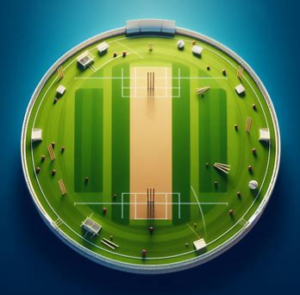The Art of the Cricket Pitch: Measurements That Matter

Batting and bowling are important for cricket. But it is very important for you to know the area on which you have to play. Yes, In this blog, we delve into the heart of the cricket pitch. We’ll explore its dimensions and the crucial role it plays in the game. So, let’s get down to the nitty-gritty and talk about the measurements that make a cricket pitch not just a strip of land, but a battleground for players.
What is a total area of a cricket pitch? What are its correct measurements? And what is the fixed distance of the particular lines drawn on it? We go through these topics today.
Total area : So first of all, let’s know about the total area of the cricket pitch. The total area of the cricket pitch, which has all the markings, should be at least 22.56 meters in length. And if we talk about feet, then 74 feet should be the length of this area for pitch marking.
Width Wonders The pitch boasts a width of 3.66 meters. This generous span ensures clarity for pitch markings and sets the stage for the players’ strategic plays.
Length Legends The length from one set of stumps to the other is a precise 20.12 meters. In the imperial system, this is the famed 22 yards or 66 feet. These numbers aren’t just figures; they’re the lifeblood of cricket strategy and lore.
Stump Stories The stumps stand as silent sentinels at either end of the pitch, defining the area where batsmen and bowlers duel. Their placement is pivotal, marking the pitch’s boundaries and influencing the game’s flow.
Stump Placement Precision Positioning the stumps is an art in itself. You’ll place half of each stump on the bowling crease, with the remainder extending behind it. This careful alignment ensures fairness and precision in the game.
The Trio of Creases A cricket pitch’s anatomy features three vital lines: the Popping (batting) crease, the Bowling crease, and the Return crease. Each plays a pivotal role in the game’s structure and players’ strategies.
Bowling Crease Insights The Bowling crease lies a strategic 4 feet 4 inches (approx 1.32 meters) from the middle stump, totaling 52 inches (approx 1.32 meters) on each side. This creates a total span of 8 feet 8 inches (approx 2.64 meters) across the pitch, marking the bowler’s territory.
Stump Width Standards When it comes to the stumps, width matters. The combined width of all three stumps should measure exactly 9 inches (approx 22.86 cm), ensuring uniformity across all cricket grounds.
The Long Run Spanning the length of the pitch, the distance between the stumps is a non-negotiable 20.12 meters (approx 22 yards) or ( approx 66 feet). This measurement is the heartbeat of the pitch, dictating the pace and play of the game.
The Popping Crease: A Critical Marker At the forefront of our pitch is the popping crease, also revered as the batting crease. This line is not merely a marking; it’s a critical component of the game. Drawn with precision, it stands 4 feet (approx 1.22 ) meters) from the bowling crease, a parallel line of immense significance.
Distance Matters: Crease to Crease The space between the popping creases is a storied expanse. It measures 17.68 meters (approx 19.3 ) yards or ( approx 58 ) feet), a distance that’s seen countless runs scored and wickets taken. This isn’t just a gap; it’s where the heart of the game beats.
The Width of the Popping Crease Guided by the International Cricket Council (ICC), the popping crease extends 45 feet to the left and right, creating a total width of 90 feet. The Marylebone Cricket Club (MCC) offers a narrower view, with 6 feet to each side, summing up to 12 feet. These are the standards that ensure consistency in cricket pitches around the globe.
The Return Crease: The Bowler’s Boundary The return crease marks the bowler’s domain, running 4 feet 4 inches (approx 1.32 ) meters) from the middle stump on both sides. This line is essential, defining the bowler’s area of play and maintaining the sport’s integrity.
The Return Crease: Umpire’s Ally The return crease plays a pivotal role in determining the bowler’s back foot no-ball. Extending 4 feet from the popping crease and at least 8 feet from the bowling crease, it can stretch as far behind the pitch as needed. This flexibility allows for clear demarcation and fair play.
Marking with Precision When marking the pitch, one rule is paramount: all lines must be drawn outside their exact points. The sole exception is the bowling crease, which is marked inside. This distinction is crucial for maintaining the integrity of the game’s rules.
Wide Ball Warnings The wide ball marking is a critical component during matches. Positioned 2 feet 11 inches from the middle stump, or about 35 inches, these marks are placed on both the leg and offside of the pitch. They serve as a guide for umpires and players alike, ensuring the game’s standards are upheld.
The Danger Zone Indicator Lastly, there’s a lesser-known but significant line on the bowling crease, signaling the danger zone. It’s set 1 foot from the middle stump on both sides of the pitch. This indicator helps maintain the pitch’s condition and alerts players to potential penalties.
Remember, the pitch is more than just a piece of land. It’s where history is made, records are broken, and legends come to life. Every match unfolds on this meticulously measured canvas, making it the cornerstone of cricket.

